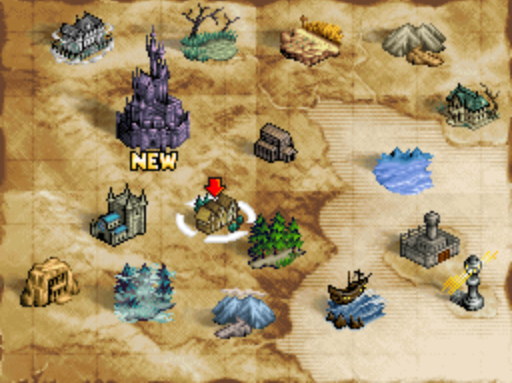Castlevania: Order of Ecclesia
Castlevania: Order of Ecclesia is the third installment of Castlevania for the Nintendo DS, and the last of the free-roaming 2-D game in the Castlevania series. It features both linear and branching areas, a new weapon/magic system, and challenging bosses.
What I enjoy most: Collecting and experimenting with the Glyph/weapon/magic system
setting
You play as Shanoa, a member of an organization dedicated to fight against Dracula. Although the Belmont clan had vanished, your organization, the Order of Ecclesia created a set of magical glyphs called “Dominus” which is said to be able to defeat Dracula. However, it was stolen by Albus, one of the members of the order - and you are tasked to take it back.
Exploration
Order of Ecclesia is structurally very different to the previous Castlevania titles. Rather than starting in one main castle (and then subsequently branching out into either an alternative castle or chaos world or smaller areas as in Portrait or Ruin), you started in the home-base of the Order of Ecclesia, and need to go through 14 different areas (plus a town), one by one, until you get to Dracula’s castle. Some of these areas have branching paths, but some are completely linear. Either way, you need to find a specific exit (and maybe defeat a boss) in order to unlock the next area. This gives the game a very different feel to its predecessors.
Dracula’s castle does provide a larger open area for one to explore, but comes quite late in the game, and is still much smaller than its counterparts in previous games. On the other hand, some of the earlier areas do contain some secrets and quest items that encourage one to revisit them a few times.
Combat & Abilities
Rather than having convention weapons and magical sub-weapons, Shanoa only equips up to 3 magical glyphs. Two of the glyph slots are for attacks, and the remaining slot is for other abilities like stats boost and extra movement abilities (e.g. flying). The two attacking slots act similarly to the dual-weapon system of SOTN, and the same glyph can be equipped in both slots for rapid fire. However, unlike conventional weapons, using these glyphs consume MP, and therefore limit one’s ability to just spam attacks continuously. The choice of attacking glyphs also determine the special attack which can be used by consuming hearts. The mixing and match of these, especially in response to the elemental weaknesses of bosses, give much depth to the gameplay.
Some key glyphs are located in strategic places throughout the game, and others can be extracted from enemies. But regardless of the glyphs one equipped, combat in Order of Ecclesia - especially the boss fights - is much more difficult than the previous few games. Healing items and better equipment, once unlocked, definitely help. And if you can defeat a boss without taking any hit, you are rewarded with a medal - which does not provide any benefit but give you a short description of the boss.
NPC and quests
Apart from Albus and your superior Barlowe, the only other NPCs are the villagers. (There is also Dracula who you fight at the end, but he does not make much appearance during the game.) Villagers are initially trapped in different areas around map, and need to be rescued by you. Once they returned to the village, they can give you quests that award you with items (some of them added to the shop) or money. Most of these are not very tedious, and provide a nice chance of pace.
Conclusion
Castlevania: Order of Ecclesia is an interesting game, but people who like the exploration and openness of metroidvania games might not enjoyable the game as much. There are many linear or nearly-linear sections in the early-to-mid game, and can be doubly frustrating if one has trouble with a boss and just want to explore some more and level up a bit before fighting it again. If you don’t mind that, you can find a challenging game with interesting combat system, beautiful graphics, and an awesome protagonist.
(2019/1/23)
List of metroidvania elements
Basic information
Name of game: Castlevania: Order of Ecclesia
Designer / Publisher: Konami
System: Nintendo DS
Year of publication: 2008
Mechanics
Style of combat: Melee
Use of magic: Yes
Combat-focus versus Platform-focus: Combat-focus
Death mechanics: Save-game
(Fall damage): No
Progression
Levelling / Farming for XP: Yes
Farming for Gold / Item: Yes
Skill pick-up: Yes
(Skill-tree): No
(Stats allocation): No
(Crafting): No
Exploration
Free-roaming: Yes
Gated by movement abilities: Yes
Gated by bosses: Yes
Type of world map: Multiple maps
World generation: Fixed map
Auto-map: Yes
Alternative game modes
New game+
Hard mode
Albus mode
Boss rush
Lv255 mode
Other elements



